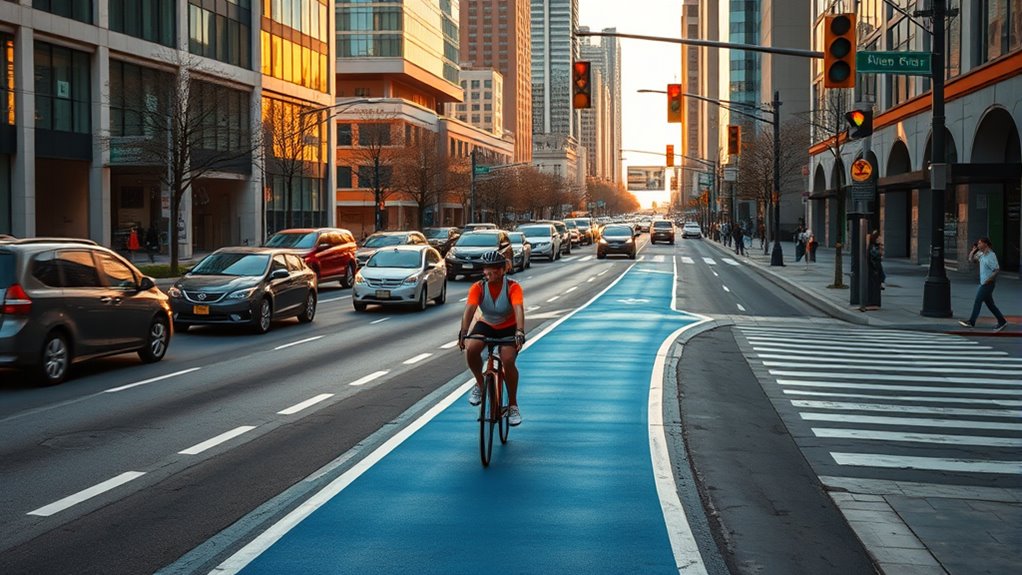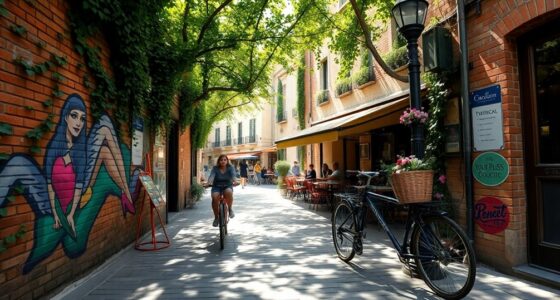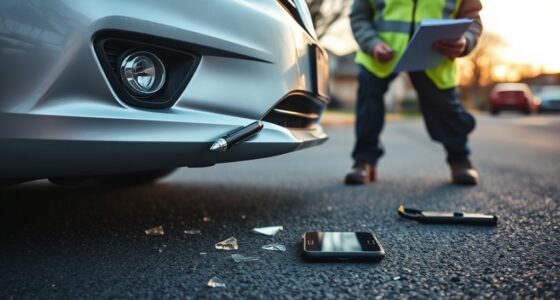To navigate city streets safely, recognize and stay within designated bike lanes marked by painted lines, symbols, or signage. Follow the rules, like riding in the same direction as traffic and keeping to the right unless signs say otherwise. Use hand signals and slow at intersections to communicate with others. Be alert for pedestrians, parked cars, and hazards. Understanding these cues and laws helps you ride confidently—keep going to learn more about staying safe and smooth in traffic.
Key Takeaways
- Recognize and stay within painted bike lane markings for safety and to prevent collisions.
- Follow road rules by cycling in the same direction as traffic and using proper signals.
- Yield to pedestrians and watch for hazards like parked cars or “dooring” risks.
- Understand signage indicating turns, restrictions, or lane usage to navigate correctly.
- Approach intersections slowly, check both ways, and respect designated bike lanes and signage.

Have you ever wondered how to move efficiently through busy city streets? Navigating these bustling areas can be tricky, especially if you’re new to cycling or unsure about the rules. The key is understanding bike lanes and the road regulations that keep everyone safe. Bike lanes are designed to offer cyclists a dedicated space, separating them from motor vehicles and pedestrians. They’re usually marked with painted lines, symbols, or specific signage. Recognizing these cues helps you stay within your designated area, reducing the risk of accidents and ensuring a smoother ride through traffic. Remember, bike lanes aren’t just for your convenience—they’re safety features that protect you and others. Always stay alert for any changes in lane markings or signs indicating upcoming turns or restrictions.
Bike lanes help cyclists stay safe and separate from traffic, marked with lines, symbols, or signs.
It’s essential to follow the road rules consistently, no matter how busy the streets get. For starters, riding in the same direction as traffic is mandatory. Cycling against traffic can be dangerous because drivers don’t expect to see a cyclist coming from that direction. Keep to the right side of the road, unless you’re in a designated lane that allows otherwise. Many cities have specific rules about where and how you can ride, so familiarizing yourself with local laws is worth the effort. At intersections, slow down and look both ways, just like drivers do. Yield to pedestrians crossing at crosswalks, and give hand signals when turning to communicate your intentions to other road users. This helps prevent misunderstandings and potential collisions. Following local laws is crucial for safe cycling practices.
Being aware of the environment around you is equally important. Watch for parked cars, as doors could suddenly open into your path—a hazard known as “dooring.” Also, stay vigilant for pedestrians, joggers, and other cyclists, especially in crowded areas. Using your bell or horn sparingly to alert others of your presence, particularly when approaching from behind or in situations where visibility is limited, enhances safety. Maintaining a predictable route and steady speed makes it easier for others to anticipate your movements, which is critical in busy city settings. Proper positioning on the road, like staying in the center of your lane or slightly to the right, helps prevent cars from trying to pass too closely. Additionally, understanding traffic laws helps you navigate complex intersections and shared spaces more confidently.
Ultimately, understanding bike lanes and road rules makes your city ride safer and more enjoyable. By respecting the designated spaces and following traffic laws, you contribute to a safer environment for everyone. Riding confidently, staying alert, and being courteous to other road users turn navigating city streets from a stressful chore into a smooth, efficient journey.
Frequently Asked Questions
How Are Bike Lane Markings Maintained and Updated?
You might wonder how bike lane markings stay clear and accurate. City crews regularly inspect and clean the markings, ensuring they’re visible and in good shape. When wear or damage occurs, they repaint or reapply the lines using reflective paint for better visibility, especially at night. Updates happen when new bike lanes are added or existing ones are modified, so you can follow posted signs and markings to stay safe and compliant.
Can Electric Bikes Use Bike Lanes?
Imagine coasting smoothly through a city street, your electric bike gliding into a designated lane. Yes, electric bikes can use bike lanes, but it depends on local regulations. Some areas treat e-bikes like regular bikes, allowing you to enjoy the dedicated space safely. Always check your city’s rules, especially if your e-bike has a higher speed or motor power, to guarantee you’re riding legally and safely.
What to Do if a Parked Car Blocks the Bike Lane?
If a parked car blocks the bike lane, you should slow down and check for any moving vehicles or pedestrians. Safely signal your intentions and, if possible, gently steer around the obstacle, ensuring you stay aware of your surroundings. If the lane is completely blocked and there’s no safe way around, consider dismounting and walking your bike until you reach a clear section. Always prioritize safety and follow local laws.
Are There Different Rules for Bike Lanes During Rush Hours?
Rush hours can feel like a traffic apocalypse, but bike lane rules stay the same—you must stay within the designated lanes and obey traffic signals. However, be extra cautious during busy times, as drivers and pedestrians are more unpredictable. Some cities might relax certain restrictions, but generally, your responsibility is to ride safely and follow all rules, no matter how hectic city streets become. Stay alert and ride responsibly.
How Do Bike Lanes Connect With Public Transit Routes?
Bike lanes often connect with public transit routes to create seamless travel options. You can usually find bike racks on buses or near transit stations, making it easy to switch between biking and public transit. Look for designated pathways that lead directly to transit stops, ensuring safe and efficient handovers. By understanding these connections, you can plan your trips better and enjoy a smoother, integrated commute across the city.
Conclusion
As you pedal through the bustling city streets, remember that bike lanes are your guiding stars in a busy sky. Embrace the rhythm of road rules like a dance, flowing with the traffic rather than fighting against it. With each turn and stop, you’re weaving a story of harmony and respect. So, keep your focus sharp and your spirit free—your journey isn’t just about getting there, but about making your mark on this vibrant urban canvas.









